Jbl L100 Iconic Bookshelf Loudspeaker Owner Manual | Specifications
Content
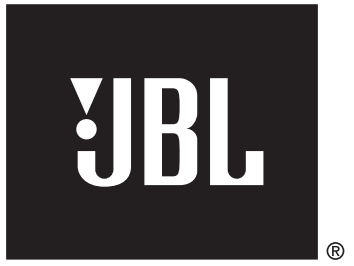
INTRODUCTION
Thank you for purchasing the JBL® L100 Classic 3-Way Loudspeaker. For more than 70 years, JBL has been providing audio equipment for concert halls, recording studios and movie theaters around the world and has become the trusted choice of leading recording artists and sound engineers. The legendary JBL 4310 professional studio monitor helped produce many of the most popular albums of the 1960s and ‘70s. The 4310 was the inspiration for the L100 home audio loudspeaker introduced in 1970, which became JBL’s all-time best selling speaker. The L100 Classic is a modern interpretation of the original L100.
The new L100 Classic honors this storied legacy with its iconic 12-inch (300mm) 3-way configuration, but with all-new drivers, crossover network, enclosure, and features to bring the design up to the highest 21st-century performance standards. Utilizing a compact monitor-type footprint, the L100 Classic features advanced JBL transducers including the JW300PW-8 Pure Pulp cone woofer, the 105H-1 Polymer-coated Pure Pulp cone midrange, and the JT025TI1-4 Titanium tweeter.
The L100 Classic retains all of the performance attributes that endeared the original L100 to listeners in the ‘70’s and ‘80s, such as exceptional dynamic range and contrast, clean and effortless high output, and precise high impact bass. The updated L100 Classic adds even greater detail resolution across the full bandwidth, lower distortion and more lifelike stereo imaging, particularly off-axis. The L100 Classic is sure to become a new legend among music lovers everywhere.
Experience the legendary sound of JBL with the L100 Iconic Bookshelf Loudspeaker. This modern version of the classic JBL L100 speaker, first introduced in 1970, features the original's iconic design and acoustic performance, combined with contemporary technology and materials. The L100 boasts a 1-inch titanium dome high-frequency driver, a 5-inch pure pulp midrange driver, and a 12-inch cast frame bass driver, all housed in a stylish, furniture-grade cabinet available in a variety of finishes. With a frequency response of 40 Hz - 40 kHz and a sensitivity of 88 dB, the JBL L100 Iconic Bookshelf Loudspeaker delivers accurate, detailed, and dynamic sound, making it the perfect choice for discerning audiophiles and music lovers alike.
SPECIFICATIONS JBL L100 Iconic Bookshelf Loudspeaker
- System Type: 3-way bookshelf loudspeaker
- Woofer: 12-inch (300mm) Pure Pulp cone (JW300PW-8)
- Midrange: 5-1/4 inch (130mm) Polymer-coated, Pure Pulp cone (105H-1)
- Tweeter: 5-1/4 inch (130mm) Polymer-coated, Pure Pulp cone (105H-1)
- Impedance: 4 ohms
- Recommended Amplifier Power: 25-200 Watts RMS
- Sensitivity (2.83V/1m): 90dB
- Frequency Response: 40Hz-40kHz (-6dB)
- Crossover Frequencies: 450Hz, 3.5kHz
- Controls: Attenuators for MF and HF Drivers
- Connector Type: Five-way gold-plated Binding Posts
- Finish: Genuine walnut veneer enclosure with Quadrex foam grille in a choice of Black, Burnt Orange or Dark Blue
- Dimensions (H x W x D): 25.06" H x 15.34" W x 14.625" D (636.6mm x 389.7mm x 371.5mm)
- Weight: 58.5 lb (26.7 kg) each
PACKAGE CONTENTS
- One L100 Classic loudspeaker
- One Quadrex foam grille
- One L100 Classic Owner’s Manual
PLACEMENT AND POSITIONING
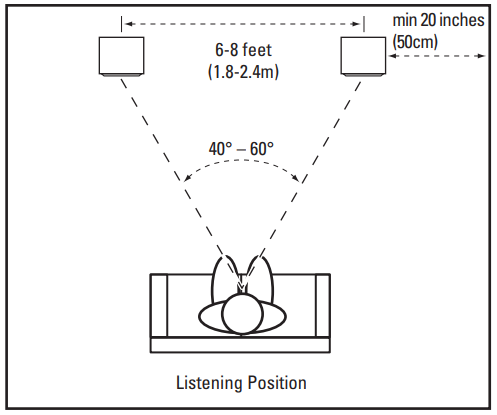
CAUTION: The L100 Classic weighs 58.8 lb. (26.7 kg) each. Before placing the speaker on a shelf or platform, be sure that it is sturdy enough to support the speaker’s weight.
Before deciding where to place your speakers, survey your room and think about placement, using the illustration below as a guide.
- Avoid placing the speakers near power amplifiers, heat registers or other objects that generate large amounts of heat.
- Do not place the speakers in very humid or dusty places.
- Do not place the speakers in direct sunlight or where they will be exposed to other intense light.
- For best results, place the speakers 6–8 feet (1.8-2.4m) apart. If you set the speakers farther apart than this, angle them toward the listening position.
- The speakers will produce the most accurate stereo soundstage when the angle between the listener and the speakers is between 40 and 60 degrees.
- Generally, bass output will increase as the speaker is moved closer to a wall or corner. For best performance, we recommend that you place the speakers at least 20 inches (50cm) away from the sidewalls.
- The speaker will yield the best stereo imaging when oriented vertically.
- The L100 Classic may be stand mounted with optional JBL metal stands (model JBL JS-120, sold separately) that angle the speaker upward.
- If not using the optional stands with built-in angle, then we recommend you to position each speaker so that its tweeter is approximately at ear level.
CONNECTIONS

CAUTION:
- Make sure that all of the system’s electrical components are turned OFF (and preferably unplugged from their ac outlets) before making any connections.
- Speakers and amplifiers have corresponding positive and negative (“+” and “–”) connection terminals.
- The L100 Classic has color-coded connection terminals. The “+” terminal is red, while the “–” terminal is black.
See the illustration on the right. The L100 Classic is designed so that a positive voltage at the “+” (red) terminal will cause the speaker drivers to move outward (toward the room). We recommend using a high-quality speaker cable with polarity coding. The side of the wire with a ridge or other coding is usually considered positive polarity (“+”). To ensure proper polarity, connect each “+” terminal on the back of the amplifier or receiver to the respective “+” (red) terminal on each speaker. Connect the “–” (black) terminals in a similar way. See your receiver or amplifier’s owner’s manual to confirm its connection procedures.
BASIC SINGLE-WIRE CONNECTION
Connect the amplifier to each speaker as shown in the illustration on the right.
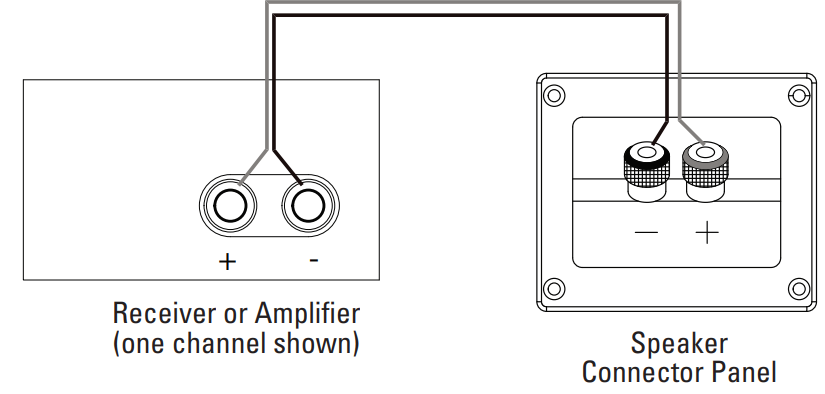
IMPORTANT: Do not reverse polarities (i.e., “+” to “–” or “–” to “+”) when making connections. Doing so will cause poor stereo imaging and diminished bass performance. The L100 Classic’s gold-plated speaker terminals can accept a variety of wire connector types: bare wire, spade connectors, pin connectors and banana connectors.
USING BARE WIRE OR PIN CONNECTORS
IMPORTANT: Make sure that the (+) and (–) wires or pins do not touch each other or the other terminal. Touching cables can cause a short circuit that can damage your receiver or amplifier.

USING SPADE CONNECTORS
IMPORTANT: Make sure the (+) and (–) spade connector blades do not touch each other or the other terminal. Touching blades can cause a short circuit that can damage your receiver or amplifier.
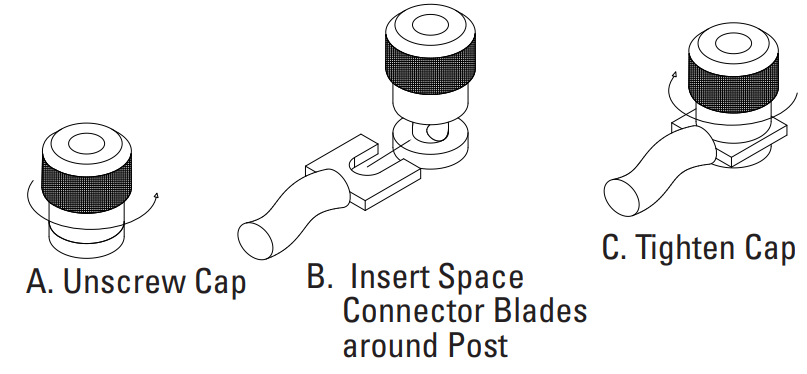
USING BANANA CONNECTORS
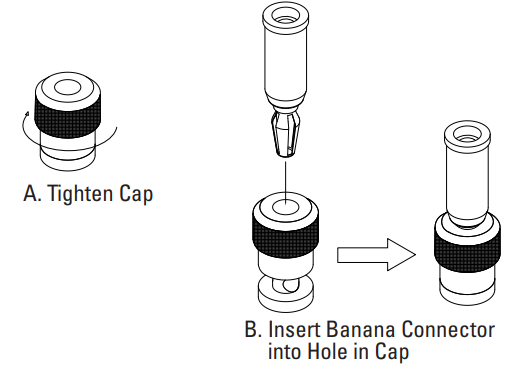
CONTROLS/ADJUSTMENTS
- The L100 Classic has front-panel adjustments that let you balance the levels of the midrange driver (MF) and tweeter (HF) relative to the woofer.
- You can use these controls to adjust the speaker’s sound according to your room’s acoustics, or your personal taste. The “0dB” default position is a good place to start. Whatever sounds best to you in your room is the right setting.
- As with most speakers, after you start playing the L100 Classic it will take the drivers’ suspensions several weeks to “break in” and achieve optimum performance.
- During this period, the balance between the woofer, midrange, and tweeter may change, so we recommend that you adjust the midrange and tweeter controls again after the break-in period.
NOTE: There is a protective plastic film on the front control panel label that may be removed.
CARING FOR YOUR SPEAKERS
- Wipe the cabinet with a clean, dry cloth to remove dust. Damp cloths or cleaning paper may dull the cabinet’s finish.
- Do not use volatile liquids such as benzene, paint thinner, alcohol, etc., on the cabinet. Do not spray insecticide near the cabinet.
- To remove dust from the foam grille, use a vacuum cleaner set to low suction. Do not wash the grille in water.
- If the surfaces of the woofer and midrange cones become dusty, you can carefully sweep them clean with a soft, dry calligraphy brush or paintbrush. Do not use a damp cloth.
- NEVER touch anything to the tweeter dome.
Troubleshooting and Maintenance
Common Problems and Solutions
- No Sound: Ensure that the speakers are properly connected to the amplifier, and that the amplifier is turned on and set to the correct input. Check the speaker wires for damage, and make sure that they are securely attached to the speakers and the amplifier.
- Distorted Sound: Check the volume level and the equalization settings on the amplifier. Make sure that the speakers are positioned correctly and not too close to walls or other surfaces that may cause sound reflections or interference.
- Rattling Noises: Check the speakers for loose screws or other hardware. Make sure that the grilles are properly attached and not vibrating. If the problem persists, try moving the speakers to a different location or using isolation pads to decouple them from the surface they are sitting on.
Instructions and Warnings
- Do not exceed the recommended power handling capacity of the speakers.
- Do not obstruct the bass reflex ports on the back of the speakers.
- Do not expose the speakers to moisture, extreme temperatures, or direct sunlight.
- Do not use harsh chemicals or abrasive materials to clean the speakers.
Pros & Cons JBL L100 Iconic Bookshelf Loudspeaker
Pros
- Classic design and modern technology
- Accurate, detailed, and dynamic sound
- Wide frequency response and high sensitivity
- Available in a variety of finishes
- Stylish and furniture-grade cabinet
Cons
- May require a powerful amplifier to drive
- Bass may be overwhelming in some settings
- Grilles may not fit securely
- Expensive compared to other bookshelf speakers
JBL L100 Iconic Bookshelf Loudspeaker Customer Reviews
Customers rave about the JBL L100 Iconic Bookshelf Loudspeaker's exceptional sound quality, with many noting that it lives up to the legacy of the original L100 speakers. Some customers have commented on the speakers' stylish appearance and high-quality construction, while others have noted that they require a powerful amplifier to drive them to their full potential. A few customers have reported issues with the grilles fitting securely, but overall, the JBL L100 Iconic Bookshelf Loudspeaker has received high praise from audiophiles and music lovers alike.
FAQs
Faqs
What is the L100 Iconic Bookshelf Loudspeaker best known for?
What type of technology is used in the L100 Loudspeakers for sound reproduction?
Are JBL L100 Iconic Bookshelf Loudspeaker powered or passive?
What is the impedance of the JBL L100 Iconic Bookshelf Loudspeaker?
How large are the JBL L100 Iconic Bookshelf Loudspeaker?
What should I do if one of my JBL L100 Iconic Bookshelf Loudspeaker is not producing sound?
How do magnetic grilles affect the sound quality of the JBL L100 Iconic Bookshelf Loudspeaker?
Can I use the JBL L100 Iconic Bookshelf Loudspeaker in a multi-room audio setup?
How do I clean and maintain the exterior of the JBL L100 Iconic Bookshelf Loudspeaker?
What is the difference between a 2-way and a 3-way loudspeaker like the JBL L100 Iconic Bookshelf Loudspeaker?
Leave a Comment
